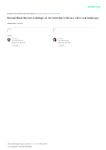Beyond Blade Runner: A dialogic of the everyday in Macau's fictional landscape
| dc.contributor.author | Brown, Robert | |
| dc.contributor.author | Latham, Zoe | |
| dc.date.accessioned | 2022-03-23T11:26:49Z | |
| dc.date.issued | 2018-08-29 | |
| dc.identifier.uri | http://hdl.handle.net/10026.1/18968 | |
| dc.description.abstract |
The movie Blade Runner has been posited as 'a metaphor of the postmodern condition,' a proposition advanced by Giuliana Bruno and David Harvey. The hybridity of the landscape depicted in the film evokes postmodernism's emphasis on 'fiction rather than function, signs rather than things' drawing as Bruno suggests on objectified, synthesised images of Hong Kong or Tokyo Bruno. Narratives of film afford much in helping us to understand our world, and ourselves within it; sci-fi cinema is no exception to this, offering us "an arena in which we can explore exactly what it is be 'human'." Yet as David Byrne reminds us, 'we can get more from science fiction than nightmares from Blade Runner.' Upon initial encounter the city of Macau would seem to have much in common with Blade Runner. Its urban fabric and its cultural and political history have generated a palimpsest-like landscape built up of layers of differing urban planning and architectural styles and typologies, each giving evidence of their temporal as well as spatial origins. The more recent addition of the commodified edifices of the casinos, utopian artefacts which offer behind their recycled facades (seemingly reproduced from, and reproducible anytime and anywhere) an intensity of introverted experience that draws one further and further into an interiorized world. The equally recent addition of the preserved landscape of the now World Heritage Site Portuguese Old-Town would seem to reinforce critiques of the sellout of place to corporate image and commercial transaction. Moving beyond the signage however, upon further investigation through a Bakhtinian, dialogical lens we find a life present in the city that has played out in the everyday. Both away from and even amidst the seeming stage sets, people ritually navigate through and appropriate space for their own intentions, and through their actions offer up other, yet simultaneous and interdependent trajectories of patterns of urban living. Such actions offer clues for future development, and a framework through which to view the past. It is such transactional events between inhabitant and their surroundings, and between inhabitant and inhabitant, that leave nebulous yet meaningful mnemonic traces of our lives upon place. As Kevin Lynch reminds us, these define the city for us as much as the strategic, panoptic projections of grand narratives upon space. This paper will use as a point of reference contemporary Macau's landscape, a setting defined by juxtapositions of culture and politics, as well as hubris and humility. It will consider what we can learn from it about urban renewal, and the dialogical relations that underpin how Macau's citizens inhabit and make meaning in their lives and lived environment. | |
| dc.language.iso | en | |
| dc.subject | cultural landscape | |
| dc.subject | dialogism | |
| dc.subject | landscape | |
| dc.title | Beyond Blade Runner: A dialogic of the everyday in Macau's fictional landscape | |
| dc.type | presentation | |
| plymouth.date-start | 2018-08-29 | |
| plymouth.conference-name | EAUH 2018 Urban renewal and resilience cities in comparative perspective | |
| plymouth.organisational-group | /Plymouth | |
| plymouth.organisational-group | /Plymouth/Faculty of Arts, Humanities and Business | |
| plymouth.organisational-group | /Plymouth/Users by role | |
| dc.publisher.place | EAUH 2018 Urban renewal and resilience cities in comparative perspective | |
| dcterms.dateAccepted | 2019-01-07 | |
| dc.rights.embargodate | 2023-7-19 | |
| dc.rights.embargoperiod | Not known | |
| rioxxterms.licenseref.uri | http://www.rioxx.net/licenses/all-rights-reserved | |
| rioxxterms.type | Conference Paper/Proceeding/Abstract |


